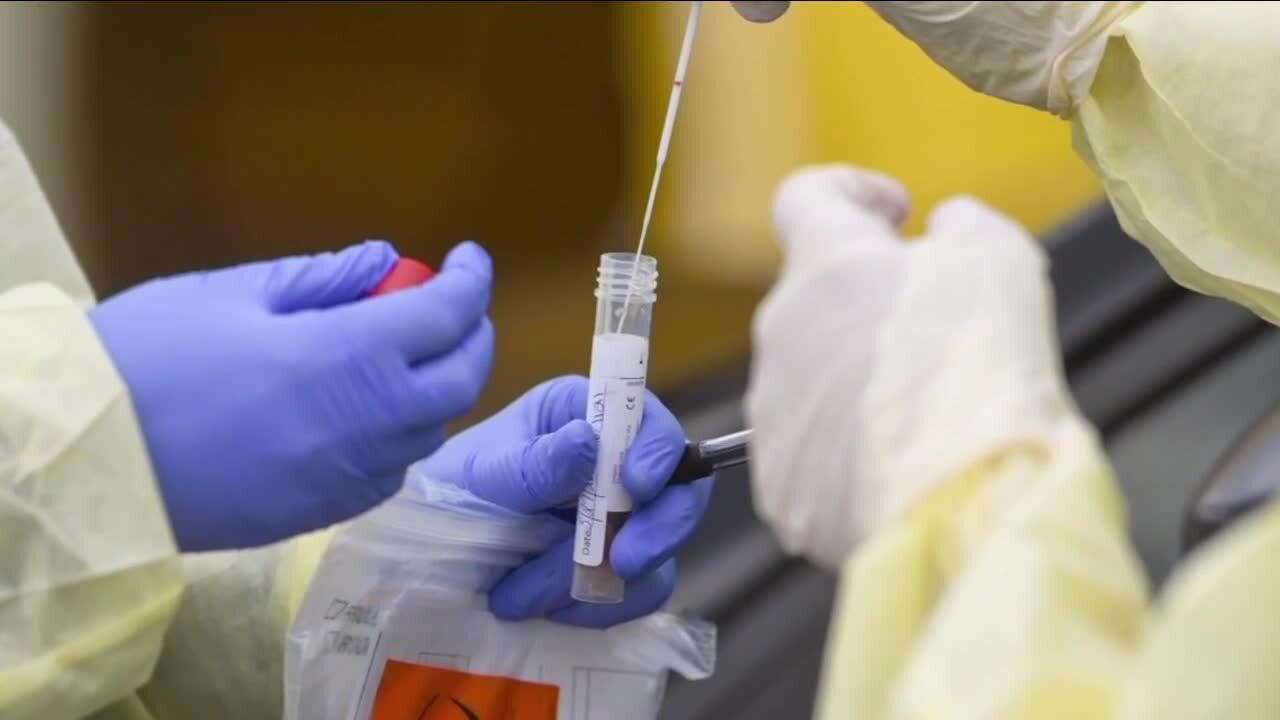CLEVELAND — Gov. Mike DeWine's experience with COVID-19 testing on Thursday has many people wondering: how can this happen?
DeWine tested positive in the morning when he received an antigen test, before receiving a negative result from a PCR test later in the afternoon.
RELATED: Gov. DeWine tests negative for coronavirus after initial positive result
Dr. Amy Ray, medical director of employee health and infection prevention for MetroHealth, explained how each type of test works. Both are diagnostic, rather than antibody, tests.
"When we think about COVID-19 testing, the most common form of testing is via PCR testing," Ray said. "And PCR essentially detects the genetic material of the virus in a person's nose or back of the throat."
The antigen test, Ray said, looks for a protein specific to the virus, instead of "looking for the viral RNA or the genetic blocks of the virus."
"So it's a protein that's made by the virus that then hangs out with an infected person in their nose or back of their throat," Ray said.
The antigen test has a rapid turnaround time for results, compared to PCR.
"PCR is the technique by which you amplify the genetic material of the virus, so it takes time to do that," Ray said. "It's looking for the specific genes encoded by virus, and then it has the technology as such that, in order for the test to be called positive or negative, that material has to be sort of replicated and that process takes time."
While there are some "pretty quick" PCR tests, with turnaround time of one or two hours, Ray said antigen testing is quicker in part because it's "simplistic. It's either the protein is there or it's not there."
For that reason, though, it's also less sensitive, not as accurate or as good at detecting the presence of the virus as a PCR test, according to Dr. Ray.
It can also result in false negatives sometimes, although false positives are unlikely.
"When we think about diagnostic tests for an infectious disease, we want the tests to be very sensitive, meaning it can detect if the virus is there," Ray said. "But as importantly, we want it to be, those tests to be very specific, so when the virus is not there."
Both types of tests are designed to be very specific and avoid false positives. The antigen test, because it is less accurate, is mostly intended to be used "in a community context," to detect asymptomatic people who may be unknowingly transmitting the disease to others.
"It's helpful if it's positive. It’s not reliable if it's negative, and oftentimes with a negative antigen test, a PCR is the follow-up test," Ray said.
But in the governor's case, "the opposite occurred where his test by antigen was positive, and then the subsequent test by PCR being negative."'
According to the Ohio Department of Health, neither of Gov.DeWine's tests were included in the daily case count. His PCR result was negative, so it was not included, and antigen tests are not reported in the daily case count. They are only included in the state's probable case count if they meet another criteria in addition to a positive test: showing symptoms or evidence that the person was exposed to someone else with the virus.
Peter Mohler, PhD, of The Ohio State University Wexner Medical Center, described PCR tests as the "gold standard" for COVID-19 testing. More than 90 percent of COVID-19 diagnostic tests performed on people in Ohio were PCR tests, according to Mohler.
Mohler said PCR tests can detect the genetic material of viruses, even in people without symptoms, with a high degree of accuracy.
He compared PCR and antigen tests to a high-powered telescope and a pair of binoculars, respectively, describing PCR testing as "incredibly sensitive and incredibly accurate." However, he said it is difficult to scale and the people who run them have had training. Still, PCR tests give a "very good impression" of what's happening at that level.
In contrast, Mohler said, antigen tests resemble a pair of binoculars.
"It's a little bit less sensitive, and so you're going to have things that we call false negatives and false positives," Mohler said. "Like binoculars, you're going to miss some stars. But the good part is you're going to be able to have lots of these across the field."
With conflicting results from Gov. DeWine's two tests on Thursday, the governor's office said he will take yet another PCR test Saturday.
Dr. Ray cautioned that no diagnostic test will perform perfectly and that both tests require a "very good specimen collection."
"The test is only as good as the person collecting the swab, their ability to really get a good sample," Ray said.
While it may not be possible to say with certainty whether the governor has or does not have COVID-19, Ray said she thinks that it would be prudent to assume having a positive test means the virus is present.
Although she doesn't know the specifics of Gov. DeWine's testing platforms or his symptoms or lack thereof, Ray said, "My recommendation were he a patient of mine, is that he stay home and monitor and watch for symptoms, and certainly we'll keep him in our thoughts and hope for a quick recovery if this is a true positive. But I think it's a much safer approach from a public health perspective to assume that a positive test equals presence of virus."
Ray said there are tradeoffs with any kind of test, even PCR testing, which is more sensitive, accurate and "very good at ruling out infection."
"The PCR test is probably at least 90 percent accurate," Ray said. "You cannot let the perfect be the enemy of the good."
She added, "With this virus, there is no gold standard test because it's not biologically safe to culture the virus. So we can't say that we can detect replicating virus in Person X because it's unethical and irresponsible to try to grow this virus in culture. So some of the things that we would traditionally rely upon, we can't rely upon, and so we use very good markers, looking for DNA, or RNA in the case of this particular virus, and proteins that are very specific for the virus."
Asked whether Ohio's agreement with other states to buy antigen tests could help control spread even given its lower accuracy, Ray said it was "very important" and added, "It's another piece of our collective success in controlling transmission" and that both antigen and PCR tests have a role, despite limitations.
"For example, if you were to use a rapid test on a population of 100 asymptomatic persons, be they church members, school groups, etc., and you found three positives on an antigen test, that would be three that you didn't know were there before testing," Ray said. "So a positive has meaning. And then those persons can then stay at home and break the chains of transmission."
Ray said it is helpful for the public to know that testing capacity is increasing.
"Over time, more and more and more tests are being done, and that means that more and more asymptomatic persons can be tested and then transmission can be interrupted, is the hope," Ray said. "Early on in the pandemic, it was crucially, and it remains crucially, important to detect patients who are coming in to the hospital setting for direct care, and it remains very important to be testing our frontline workers, our EMS, our fire, our health care workers, etc."
While she is encouraged by testing availability, she said there is a "legitimate problem" with the supply chain and testing and that there are constraints.
"But the good news is there is more testing available now than there was a month ago, than there was two months ago," Ray said. "So I think we're moving in the right direction. There's a lot of ground yet to be gained. But I think we're moving towards a better place in terms of use of tests to avoid transmission."
Additional Coronavirus information and resources:
See complete coverage on our Coronavirus Continuing Coverage page.
Rebound Northeast Ohio News 5's initiative to help people through the financial impact of the coronavirus by offering one place to go for information on everything available to help and how to access it. We're providing resources on:
Getting Back to Work - Learn about the latest job openings, how to file for benefits and succeed in the job market.
Making Ends Meet - Find help on topics from rent to food to new belt-tightening techniques.
Managing the Stress - Feeling isolated or frustrated? Learn ways to connect with people virtually, get counseling or manage your stress.
Doing What's Right - Keep track of the way people are spending your tax dollars and treating your community.
We're Open! Northeast Ohio is place created by News 5 to open us up to new ways of thinking, new ways of gathering and new ways of supporting each other.
Click here for a page with resources including a COVID-19 overview from the CDC, details on cases in Ohio, a timeline of Governor Mike DeWine's orders since the outbreak, coronavirus' impact on Northeast Ohio, and link to more information from the Ohio Department of Health, the Cuyahoga County Board of Health, the CDC and the WHO.
See data visualizations showing the impact of coronavirus in Ohio, including county-by-county maps, charts showing the spread of the disease, and more.
The CDC and the Ohio Department of Health are now recommending the use of cloth face coverings in public to slow the spread of COVID-19.
Read more about the CDC's recommendation here. Here is a step-by-step guide on how to make a face mask from common household materials, without having to know how to sew.
View a global coronavirus tracker with data from Johns Hopkins University.





